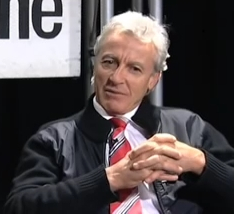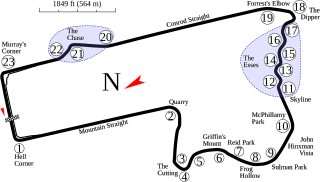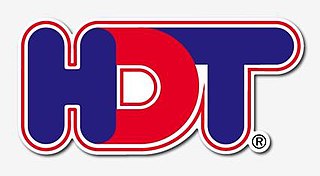
Peter Geoffrey Brock, known as "Peter Perfect", "The King of the Mountain", or simply "Brocky", was an Australian motor racing driver. Brock was most often associated with Holden for almost 40 years, although he raced vehicles of other manufacturers including BMW, Ford, Volvo, Porsche and Peugeot. He won the Bathurst 1000 endurance race nine times, the Sandown 500 touring car race nine times, the Australian Touring Car Championship three times, the Bathurst 24 Hour once and was inducted into the V8 Supercars Hall of Fame in 2001. Brock's business activities included the Holden Dealer Team (HDT) that produced Brock's racing machines as well as a number of modified high-performance road versions of his racing cars.

The Holden Monaro is a car which was manufactured by General Motors' Australian division Holden. It has a front-engine, rear-wheel-drive layout and was produced with a two-door coupé body from 1968 to 1975 and again from 2001 to 2006 and with a 4-door sedan body from 1973 to 1977.

The Bathurst 1000 is a 1,000-kilometre (621.4 mi) touring car race held annually on the Mount Panorama Circuit in Bathurst, New South Wales, Australia. It is currently run as part of the Supercars Championship, the most recent incarnation of the Australian Touring Car Championship. In 1987 it was a round of the World Touring Car Championship. The Bathurst 1000 is colloquially known as The Great Race among motorsport fans and media. The race originated with the 1960 Armstrong 500 at the Phillip Island Grand Prix Circuit; it was relocated to Bathurst in 1963 and has continued there every year since. The race was traditionally run on the New South Wales Labour-Day long weekend in early October. Since 2001, the race has been run on the weekend following the long weekend, generally the second weekend of October.

Steven James Richards is a New Zealand-Australian racing driver, currently competing in the Porsche Carrera Cup Australia Championship.

Walkinshaw Andretti United is an Australian motor racing team based in the Melbourne suburb of Clayton. The team, initially branded as the Holden Racing Team, used to field Holden Commodores in the Supercars Championship before making the switch to Ford Mustangs for the 2023 season. The two cars are currently driven by Nick Percat and Chaz Mostert.

Jim Richards is a New Zealand racing driver who won numerous championships in his home country and in Australia. While now retired from professional racing, Richards continues to compete in the Touring Car Masters series.

Gregory Murphy is a New Zealand professional racing driver, best known as a four-time winner of the Bathurst 1000. Greg Murphy joined Jeremy Clarkson and James May presenting Top Gear Live, when it had its first international Live show at ASB Showgrounds in Auckland from 12 to 15 February 2009, and again when the show returned in 2010.

The Holden Dealer Team (HDT) was Holden's semi-official racing team from 1969 until 1986, primarily contesting Australian Touring Car events but also rallying, rallycross and Sports Sedan races during the 1970s. From 1980 the Holden Dealer Team, by then under the ownership of Peter Brock, diversified into producing modified road-going Commodores and other Holden cars for selected dealers via HDT Special Vehicles.

Garth Tander is a multiple-championship winning Australian motor racing driver competing in the Virgin Australia Supercars Championship's Enduro Cup, co-driving the No. 97 Holden ZB Commodore for Triple Eight Race Engineering. He was the 2007 series champion for the HSV Dealer Team and is a five-time winner in Australia's most prestigious motor race, the Bathurst 1000.

Todd Kelly is a retired Australian professional racing driver who competed in the Virgin Australia Supercars Championship. He is the older brother of fellow Supercars driver and former Bathurst 1000 winner, Rick Kelly. He drove for the Holden Racing Team from 2003 until 2007, and Perkins Engineering in 2008. Since 2009, he has been with his family team Kelly Racing. He is the youngest driver to have reached 100 starts in the series.
Garry Rogers Motorsport is an Australian motor racing team. It is owned by retired racing driver Garry Rogers who began the team to further his own racing efforts. Based in Melbourne, originally out of a Nissan dealership owned by Rogers, the team has competed in a variety of touring car series in Australia ranging from relatively modest Nissan production cars to Chevrolet NASCAR race cars to building the GT specification Holden Monaro 427C. The team won the Bathurst 1000 in 2000 and also won both of the Bathurst 24 Hour races which were held in 2002 and 2003. In 2013 the team celebrated its 50th year in racing since Rogers made his debut.

The Sandown 500 is an annual endurance motor race which is staged at the Sandown Raceway, near Melbourne, Victoria, Australia from 1964. The event's name, distance – and the category of cars competing in it – has varied widely throughout its history. Most recently, the event was held as a championship event for Supercars from 2003 to 2007 and from 2012 to 2019.

The Australian Nations Cup Championship was a motor racing title sanctioned by the Confederation of Australian Motor Sport (CAMS) from 2000 to 2004.

The 2002 Bathurst 24 Hour was an endurance motor race staged at the Mount Panorama Circuit just outside Bathurst in New South Wales, Australia. The race, which was the first 24-hour event to be held at Mount Panorama, started at 4:00pm on 16 November and finished at 4:00pm on 17 November. It was the first 24 Hour race to be held in Australia since the 1954 Mount Druitt 24 Hours Road Race.

The 2003 Bathurst 24 Hour was a motor race staged at the Mount Panorama Circuit just outside Bathurst in New South Wales, Australia. The race started at 2:00pm on 22 November 2003 and finished at 2:00pm on 23 November. It was the second Bathurst 24 Hour.

The Australian GT Championship is a CAMS-sanctioned national title for drivers of GT cars, held annually from 1960 to 1963, from 1982 to 1985 and from 2005. Each championship up to and including the 1963 title was contested over a single race and those after that year over a series of races. The categories which have contested the championship have not always been well defined and often have become a home for cars orphaned by category collapse or a sudden change in regulation.

The Bathurst 24 Hour was an endurance race for GT and production cars held at the Mount Panorama Circuit in Bathurst, New South Wales in 2002 and 2003. Only two races were held before the collapse of the management organisation PROCAR. Both races were won by V8 Supercar team Garry Rogers Motorsport with Holden Monaros.
The 2004 Australian Nations Cup Championship was an Australian motor racing competition for modified production-based coupes complying with "Nations Cup" regulations. Contested as part of the 2004 Procar Championship Series, it was sanctioned by the Confederation of Australian Motor Sport as a National Championship with PROCAR Australia Pty Ltd appointed as the Category Manager.
Procar Australia was a motorsport category management company which operated in Australia from 1994 to 2004.

Nathan Pretty is an Australian racecar driver.














